Creating a welcoming living room can be challenging. Many homeowners make layout mistakes that disrupt their space’s harmony. These design flaws can turn your cozy haven into a cluttered mess.
Let’s explore how to sidestep these pitfalls. We’ll learn to craft a truly harmonious space that works for you.
Your living room is the heart of your home. It’s where you relax, entertain, and spend time with loved ones. Avoiding common design flaws is crucial for its functionality and appeal.
Understanding these mistakes helps create a layout that looks great. It also ensures your living room serves your lifestyle needs perfectly.
Key Takeaways
- Avoid pushing furniture against walls for a more inviting space
- Mix old and new pieces to add character to your living room
- Choose the right size rug to frame your furniture properly
- Incorporate various light sources for layered, ambient lighting
- Consider armchairs for flexibility and visual appeal
- Test your layout to ensure efficient traffic flow and functionality
- Balance minimalism with patterns to add depth and texture
Understanding the Importance of a Well-Designed Living Room
A well-designed living room blends functionality and beauty. Space planning ensures the room supports daily activities and social gatherings. It creates a balance between practicality and aesthetics.
Interior designers stress the need for a focal point. This guides furniture placement and sets the room’s tone. Choosing the right furniture size is crucial.
Oversized pieces can crowd small rooms. Small furniture may look out of place in larger spaces. Proper sizing creates harmony in the room.
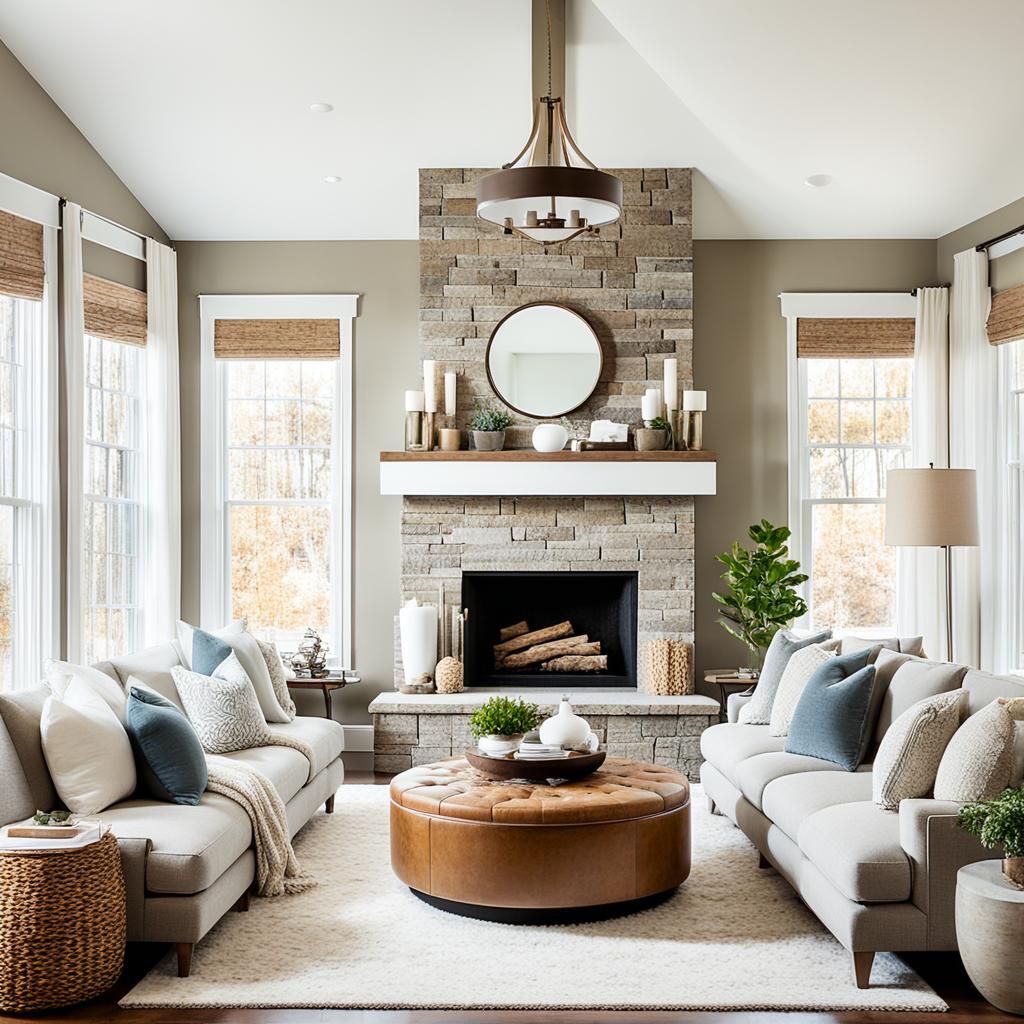
Proper circulation is vital for a functional living room. Leave 16-18 inches between the sofa and coffee table. Keep seating within 8 feet to encourage conversation.
“All rooms should have a defined traffic pattern to ensure easy movement and prevent accidents.”
Lighting is crucial in living room design. Use a layered approach with pendants, lamps, and sconces. This creates optimal ambient lighting and enhances the room’s atmosphere.
| Element | Recommendation |
|---|---|
| Sofa-to-coffee table distance | 16-18 inches |
| Ideal walkway width | 24-36 inches |
| Pendant light height | 30-36 inches above surface |
| Wall sconce height | About 6 feet from floor |
Consider these elements to create a harmonious living room. A well-designed space enhances your daily life. It combines functionality and aesthetics seamlessly.
Mismatching Your Floor Plan and Lifestyle
A lifestyle-oriented design approach is key for creating a suitable living room. Many homeowners overlook their daily routines when planning their space. This can cause frustration and inefficiency later on.
Considering Your Daily Routines
Your living room should mirror your lifestyle. Think about what you need daily. Do you want a reading nook or a coffee spot?
Architect Jennifer L. Killian Smith highlights the importance of natural light. She suggests placing windows strategically based on your home’s orientation.
Accommodating Guest Needs
Don’t forget about guests when planning your space. Leigh Ann Raines from Chic By Design emphasizes suitable dining areas. She notes we need spaces to gather and socialize.
Consider flexible seating options that can adapt for visitors.
Balancing Indoor and Outdoor Spaces
A smooth indoor-outdoor flow can enhance your living area. Mark Bittoni of Bittoni Architects warns against narrow hallways that block this connection. Instead, create wide openings to outdoor spaces for easy movement.
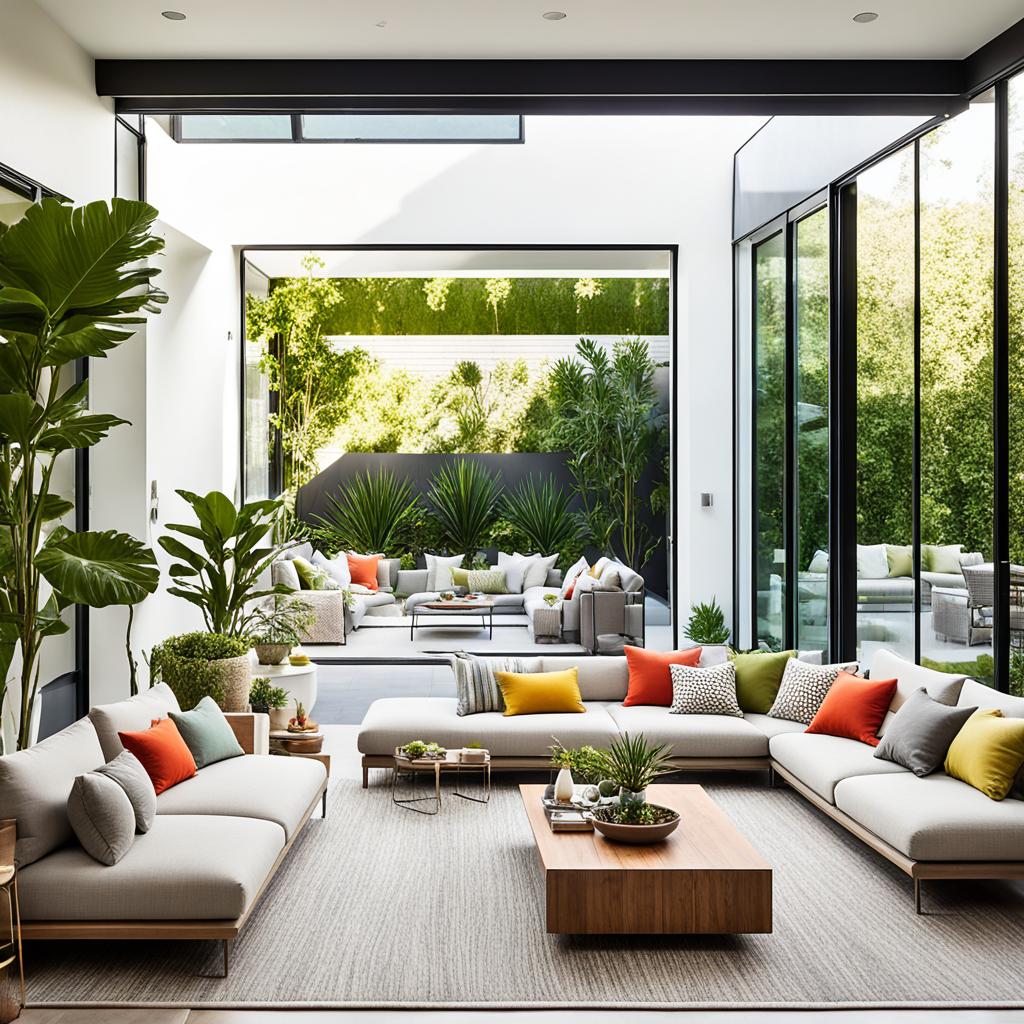
Your living room should reflect your lifestyle. Consider your routines, guest needs, and indoor-outdoor flow. This will help you create a space that truly works for you.
Avoid mismatching your floor plan and lifestyle. This common mistake can prevent you from having a harmonious home.
The Form vs. Function Dilemma
Balancing form and function is key to creating a great living room. Designers must blend practical design with visual appeal. This balance ensures your space looks good and works well for everyday use.
The layout of your living room elements is crucial. Furniture placed too far apart can make conversation difficult. Too many large pieces can make the room feel small. Finding the right balance is essential.

| Design Element | Form Consideration | Function Consideration |
|---|---|---|
| Sofa | Stylish fabric, color coordination | Comfortable seating, durability |
| Lighting | Decorative fixtures | Proper illumination for tasks |
| Flooring | Attractive materials | Easy to clean, slip-resistant |
| Storage | Visually appealing cabinets | Ample space for belongings |
A well-balanced living room blends form and function seamlessly. It’s not just about looks, but how it meets your daily needs. Consider both aspects to create a beautiful and practical space.
Space Allocation and Traffic Flow
Smart space allocation and smooth traffic flow are crucial for a functional living room. Let’s explore how to create a harmonious layout. We’ll focus on making the most of your space.
Minimizing Wasted Space
Cut down on wasted space to maximize usable areas. Leave three feet between furniture pieces for comfort and room efficiency. For small living rooms, use multipurpose furniture and mirrors.

Creating Efficient Walkways
Efficient walkways are vital for a well-designed living room. Avoid blocking doorways when arranging furniture. In rectangular rooms, add round shapes to break monotony and improve flow.
Optimizing Room Connections
Think about how your living space connects to other areas. Place the main furniture piece against the most prominent wall. This frees up space for better movement.
Consider dividing large living rooms into distinct areas. Create separate zones for seating, dining, and entertainment. This approach maximizes space usage and reduces noise from different activities.
“The art of space allocation lies in creating a balance between comfort and functionality.”
A well-planned living room layout boosts aesthetics and usability. Focus on space allocation, traffic flow, and room connections. You’ll create a living space that’s both beautiful and practical.
Common Living Room Layout Mistakes to Avoid
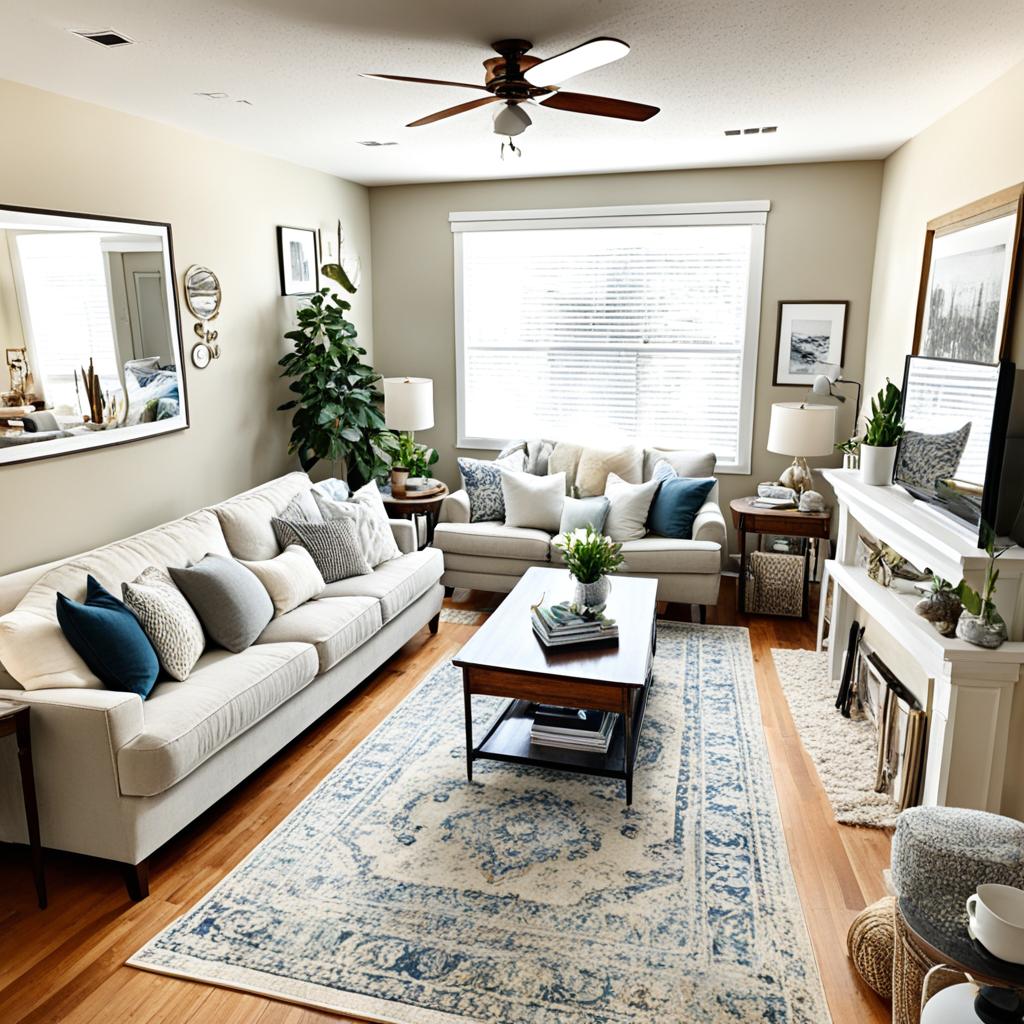
Designing a harmonious living space can be tricky. Many people make common mistakes when arranging their living rooms. Let’s look at some layout errors to avoid for a more inviting space.
A big mistake is pushing all furniture against the walls. This can create a huge empty space in the middle. Try making cozy groups around focal points like fireplaces or TVs instead.
Ignoring the room’s function is another error. Your furniture setup should match how you use the space daily. Think about traffic flow and make clear paths to avoid obstacles.
Misplacing rugs can make a room feel disjointed. Make sure your rug is the right size for your seating area. This simple step can greatly improve your room’s look.
- Not including enough seating options
- Making the TV the sole focal point
- Neglecting to create zones in larger spaces
- Overlooking proper lighting
Bethany Struble, an interior designer, warns against overcrowding. She says, “Keep your space functional by choosing each piece carefully.” In smaller rooms, use multi-purpose furniture for storage and style.
Achieving balance is crucial. Mix up the size and shape of your furniture and decor. The “golden ratio” of 2:3 can help you pick the right sizes.
By avoiding these layout mistakes, you’ll create a living room that’s both beautiful and practical.
Furniture Placement and Sizing Errors
Proper furniture placement and sizing are key to a well-designed living room. Let’s look at common mistakes and how to avoid them. This will help you create a more harmonious space.
Pushing Furniture Against Walls
Pushing furniture against walls can make your space feel cramped. Try ‘floating’ your furniture instead. This creates a more open feel and improves traffic flow.
Aim for at least 36 inches of clearance for walkways. This ensures easy movement throughout the room.
Choosing the Wrong Sofa Size
Sofa sizing is crucial in living room design. An oversized sofa can overwhelm a small space. An undersized one may look out of place in a large room.
Consider using multiple smaller sofas or a longer sofa with one chaise. These options can help balance comfort and spaciousness in your living area.
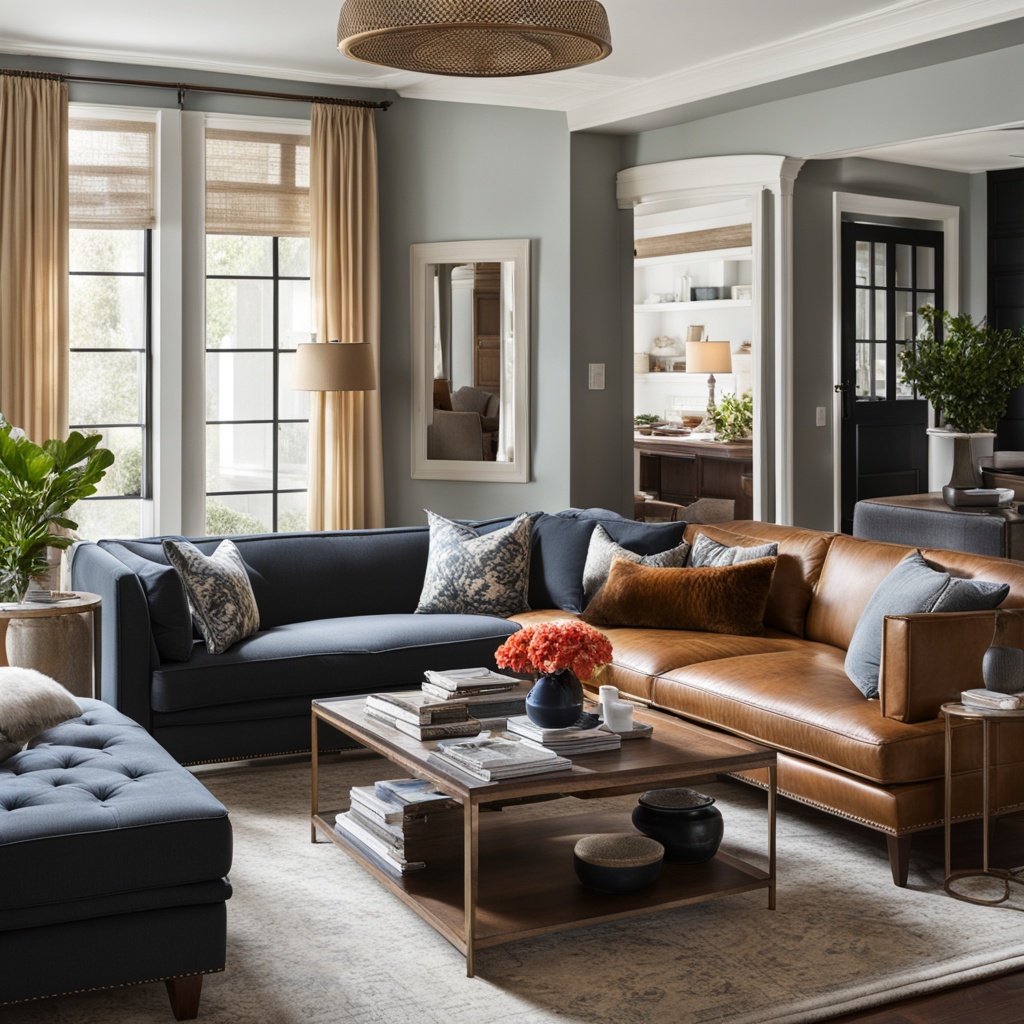
Neglecting Scale and Proportion
Ignoring scale and proportion can lead to an unbalanced look. Mix furniture heights to create visual interest and avoid monotony. Pair a low coffee table with taller side tables.
Nightstands should complement your bed size. Ottomans should be slightly shorter than chair height for proper scale.
| Furniture Item | Sizing Guideline | Common Mistake |
|---|---|---|
| Rug | At least two legs of each furniture piece on it | Choosing rugs that are too small |
| Seating | No more than 10 feet apart | Placing furniture too far apart for conversation |
| Coffee Table | 18 inches from sofa front | Selecting undersized tables that lack functionality |
| Walkways | Minimum 36 inches clearance | Not allowing enough space for easy movement |
Avoiding these common furniture placement and sizing errors is crucial. It helps create a balanced and functional living room. Your space will be more comfortable and stylish.
Lighting Pitfalls in Living Room Design
Living room lighting is key to great interior design. Many rely on a single overhead light, creating harsh shadows. This can make a space feel unwelcoming.
Layered lighting is the solution. It combines ambient, task, and accent lighting. Ambient light illuminates the whole room. Task lighting focuses on specific areas. Accent lighting highlights decor.

Use various light sources for a well-lit living room. Mix ceiling fixtures, wall sconces, floor lamps, and table lamps. This allows you to adjust lighting for different needs and moods.
Install dimmers to control light intensity. They help create a cozy atmosphere when needed.
| Light Type | Purpose | Examples |
|---|---|---|
| Ambient | Overall illumination | Ceiling fixtures, recessed lights |
| Task | Focused lighting for activities | Reading lamps, under-cabinet lights |
| Accent | Highlight decor elements | Wall sconces, picture lights |
The right lighting enhances your living room’s features. It creates a warm, inviting space. Avoid common pitfalls and use thoughtful lighting design.
This approach will transform your living room. It becomes a comfortable area for relaxation and entertainment.
The Art of Mixing Old and New Pieces
Blending vintage and modern elements creates a unique living space. It tells your story through furniture. By mixing styles, you craft a room that’s trendy and timeless.
Creating Visual Interest
Combining different eras adds depth to your living room. Try pairing a sleek modern sofa with an antique coffee table. This contrast draws the eye and sparks conversation.
Quality matters more than age in furniture selection. High-end vintage pieces can complement pricier modern items. This approach saves money without sacrificing style.
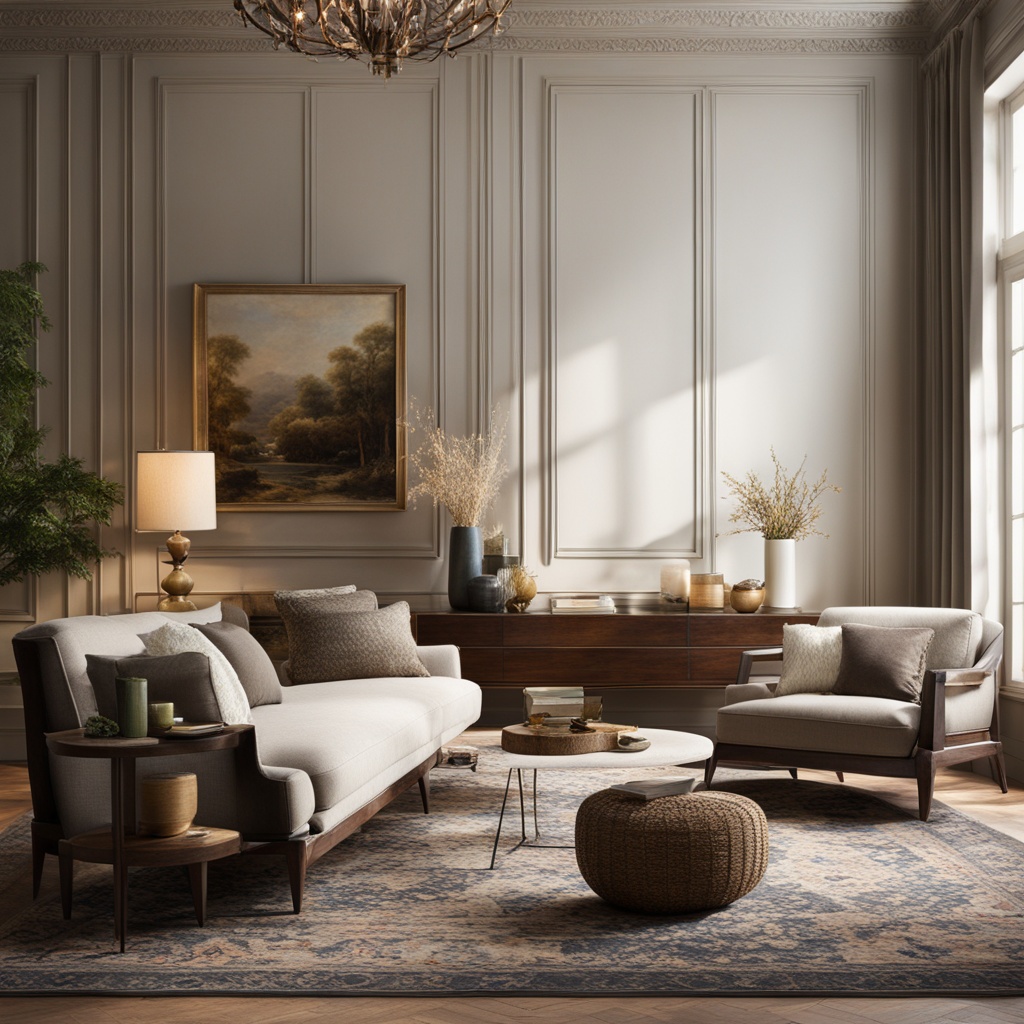
Balancing Different Styles
Achieving harmony when mixing old and new requires careful thought. Focus on proportions, shapes, and colors. A modern sectional might clash with a traditional Chippendale table.
However, a lucite and brass coffee table works with both styles. Aim for a dominant look – either modern or traditional. This creates better balance than an even split.
Incorporating Statement Pieces
Statement pieces anchor your eclectic design. A bold modern lighting fixture or ornate antique mirror can tie the room together. Don’t shy away from abstract art or unique sculptures.
These elements add personality to your space. They also serve as great conversation starters for guests.
| Universal Elements | Purpose |
|---|---|
| Oriental rugs | Ground the space |
| Abstract art | Add modern flair |
| Ornate mirrors | Reflect light and style |
| Modern side tables | Provide functional contrast |
There’s no strict rulebook for mixing furniture styles. Trust your eye and have fun creating your unique space. Your choices will showcase a blend of vintage charm and modern sophistication.
Rug Selection and Placement Blunders
Picking the right area rug for your living room can be tough. Many people make sizing and placement mistakes. These errors can affect the overall look of their space.
Living room rugs define spaces and add comfort. A common error is choosing rugs that are too small. For most living rooms, an 8×10 or 9×12 rug works best.
Smaller rugs can make the room feel tiny. Anything under 6×9 usually looks undersized in a living room.
Proper rug placement is crucial. Your rug should fit at least the front legs of all furniture. This creates a unified look and ties the room together.
For example, if your sofa is 7 feet long, your rug should be at least 9 feet wide. This ensures proper coverage and balance.
Consider the room’s purpose and traffic when selecting an area rug. Outdoor rugs can work well indoors in high-traffic areas. For dining rooms, avoid thick rugs that interfere with chair movement.
| Room Type | Recommended Rug Size | Placement Tip |
|---|---|---|
| Living Room | 8×10 or 9×12 | At least front legs of furniture on rug |
| Bedroom (Queen/King) | 9×12 | Extend 18″ beyond sides of bed |
| Dining Room | Varies | Large enough for chairs when pulled out |
A well-chosen rug can transform your living space. By avoiding these common mistakes, you’ll create a harmonious and stylish room.
Conclusion: Crafting a Harmonious Living Space
A harmonious living room needs careful planning and attention to detail. A functional layout is crucial for a balanced design that shows your style. Start with a clear focal point as the centerpiece for your room’s arrangement.
Choose furniture that fits well together and in your space. Create distinct zones for various activities to personalize your living area. This ensures your room caters to your lifestyle needs.
Lighting is vital in crafting a harmonious living room. Use floor lamps, table lamps, and sconces to create different moods. Mirrors can help brighten your space and improve the overall ambiance.
Balance is key to achieving a cohesive look. Mix patterns and textures carefully to avoid an overwhelming appearance. Address these aspects to create a beautiful and practical living room.
